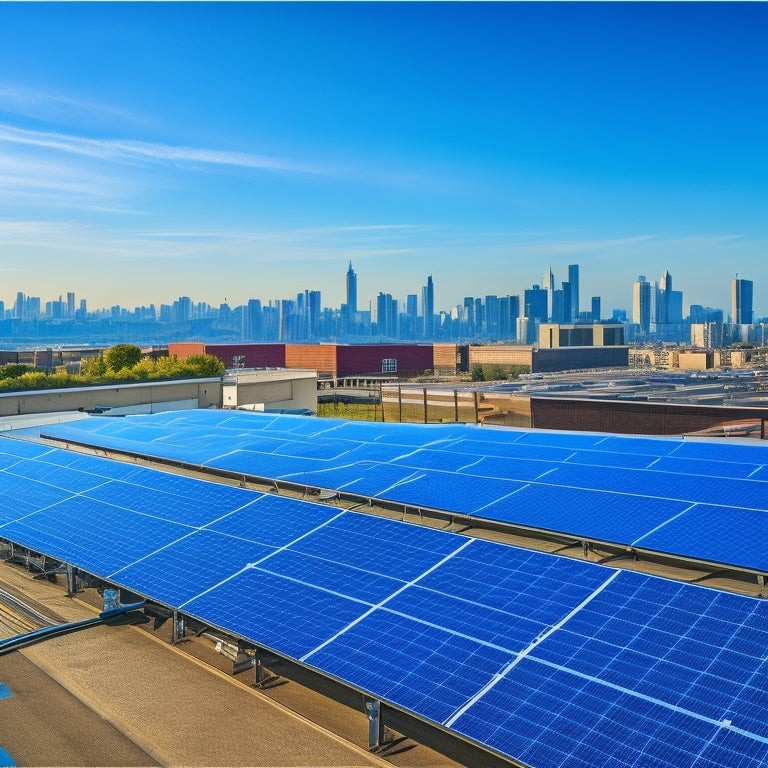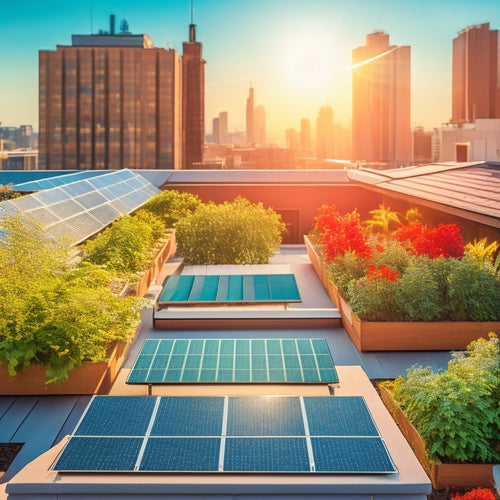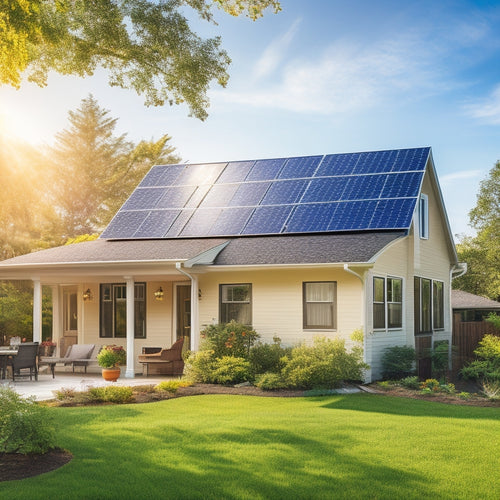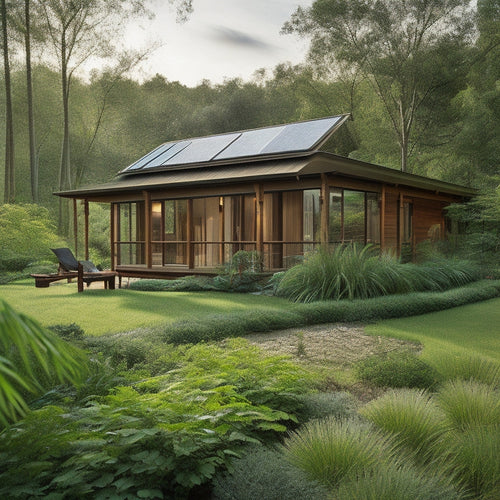
What Are the Top Things to Know About Commercial Solar Electric Systems
Share
When considering a commercial solar electric system, you'll want to know that it utilizes sunlight to generate electricity, reducing grid reliance, and that monitoring systems track energy production and identify potential issues. You'll also benefit from clean energy, enhanced brand reputation, and significant cost savings. System design and installation require careful consideration of building specifications and site assessments. While upfront costs vary, financing options and incentives like tax credits and grants are available. Ongoing maintenance is essential, and regular inspections can prevent downtime. As you investigate these key aspects, you'll realize how a well-executed commercial solar electric system can change your business.
Key Takeaways
- Commercial solar electric systems generate clean energy, reducing reliance on fossil fuels and minimizing carbon footprint.
- A well-designed system can provide energy independence, controlling energy costs and reducing expenses.
- Upfront costs range from $2.50 to $3.50 per watt, but long-lasting systems (25+ years) offer long-term energy savings.
- Financing options include tax credits, leasing options, and grant programs like REAP, with depreciation benefits yielding tax savings.
- Regular maintenance, including cleaning and panel damage inspections, is crucial for peak performance and prolonging system lifespan.
How Commercial Solar Works
Commercial buildings with commercial solar electric systems harness the sun's energy to generate electricity, reducing their reliance on the grid and lowering their utility bills.
You'll typically see photovoltaic (PV) panels installed on rooftops or in parking garages, converting sunlight into direct current (DC) electricity. An inverter then converts the DC power into alternating current (AC) electricity, which is what your building uses.
Your commercial solar electric system will often include a monitoring system to track energy production and identify any issues.
You may also consider adding commercial energy storage, such as batteries, to store excess energy generated during the day for use during periods of low sunlight or at night. This enhances your solar energy efficiency and reduces your reliance on the grid even further.
The system is designed to operate in conjunction with the existing electrical infrastructure, so you can still draw power from the grid when needed.
With a well-designed commercial solar electric system, you can increase your energy independence and reduce your operating costs.
Benefits of Solar Energy Systems
By integrating a solar energy system into your commercial building, you'll unbolt a multitude of benefits that can positively impact your bottom line and the environment.
One of the most notable advantages of solar energy is the reduction of your environmental impact. Going solar means you'll be generating clean energy, reducing your reliance on fossil fuels, and minimizing your carbon footprint. This not only benefits the planet but also enhances your brand reputation and appeals to environmentally conscious customers.
Some of the key benefits of solar energy systems include:
-
Energy Independence: With solar energy, you're no longer at the mercy of fluctuating energy prices. You'll have control over your energy costs, reducing your expenses, and increasing your profitability.
-
Reduced Operating Expenses: Solar energy can markedly reduce your energy bills, freeing up resources for other business-critical areas.
-
Increased Property Value: Installing a solar energy system can increase your property value, making your commercial building more attractive to potential buyers or tenants.
System Design and Installation
As you prepare to leverage the power of solar energy, a well-designed and installed system is vital to maximize its benefits. A commercial solar electric system's performance is heavily reliant on its system layout, which involves strategically placing panels to optimize energy production.
You'll want to ascertain your system is designed to accommodate your building's design, considering factors like roof size, orientation, and shading.
During the installation process, a thorough site assessment will help identify potential obstacles and opportunities for optimization. Your installation team will work with you to create a customized system layout that meets your energy needs and budget.
It's imperative to have a clear understanding of the installation timeline, including the permitting process, equipment delivery, and actual installation. Typically, commercial solar electric system installations can take anywhere from a few weeks to several months, depending on the complexity of the project.
Cost and Financing Options
You're likely considering the cost of a commercial solar electric system and how you'll finance it.
Upfront system costs can be significant, but you'll want to investigate the financing incentives available to offset these expenses.
Upfront System Costs
The cost of a commercial solar electric system is a significant upfront investment, with prices ranging from $2.50 to $3.50 per watt, depending on the system's size and quality.
You'll need to assess this upfront cost carefully, as it will impact your business's bottom line.
When evaluating the cost of a commercial solar electric system, keep in mind the following key factors:
-
System longevity: A high-quality system will last for 25 years or more, providing a long-term source of clean energy and significant energy savings.
-
Energy savings: By generating your own electricity, you'll reduce your reliance on the grid and lower your energy bills.
-
System design and installation: The complexity of the system design and the experience of the installation team will also impact the upfront cost.
Financing Incentives Available
While evaluating the upfront costs of a commercial solar electric system, it's equally important to investigate the financing incentives available to offset these expenses. You may be eligible for tax credits, which can greatly reduce your taxable income.
Leasing options and power purchase agreements can also provide a low-cost way to access renewable energy without a large upfront investment. Additionally, grant programs like the Rural Energy for America Program (REAP) offer funding opportunities for commercial solar projects.
Don't forget to take into account depreciation benefits, which can provide considerable tax savings over time. When conducting your financial analysis, be sure to factor in these incentives to optimize your investment returns.
With the right financing strategy, you can maximize the benefits of your commercial solar electric system and generate a strong return on investment. By leveraging these incentives, you can make your renewable energy project more financially viable and accelerate your shift to clean power.
Maintenance and Repair Needs
You'll need to establish regular cleaning schedules to guarantee your commercial solar electric system operates at peak efficiency.
Moreover, you should be prepared to replace inverters at recommended intervals to prevent system downtime.
In addition, regular panel damage inspections will help you identify and address potential issues before they impact energy production.
Regular Cleaning Schedules
Dust and debris accumulating on your commercial solar electric system's panels can greatly reduce its energy output. This is why regular cleaning schedules are crucial to maintain peak performance.
You should consider implementing a cleaning routine that suits your system's specific needs.
To guarantee maximum energy output, you'll want to adopt effective cleaning techniques and determine the ideal frequency for your system. Here are some key considerations:
-
Assess environmental factors: If your system is located in an area with high levels of air pollution, dust storms, or nearby construction, you may need to clean your panels more frequently.
-
Choose the right cleaning method: Select a cleaning technique that suits your system's panel type, such as water-based or dry cleaning methods.
-
Schedule regular cleaning: Clean your panels at least every 6 months, or more frequently depending on environmental conditions, to maintain peak energy output.
Inverter Replacement Cycles
Kick-starting your maintenance routine involves understanding inverter replacement cycles, a vital aspect of maintaining your commercial solar electric system's overall health.
You need to be aware that inverters have a limited lifespan, typically ranging from 10 to 15 years, depending on the inverter technology and operating conditions. As your system ages, the inverter's efficiency will degrade, leading to reduced energy production and increased downtime.
You should plan to replace your inverters every 10 to 12 years to guarantee your system operates at peak levels. Failing to do so can result in significant losses in energy production, ultimately affecting your bottom line.
It's essential to monitor your inverter's performance regularly, tracking key metrics such as efficiency, voltage, and temperature. This will enable you to identify potential issues early on and schedule replacement before they cause significant downtime.
Panel Damage Inspection
Your commercial solar electric system's panels are its most visible components, and they're also the most susceptible to damage from environmental factors, debris, and other external influences.
As a result, regular panel damage inspections are essential to guarantee your system operates at peak performance.
You should inspect your panels regularly for signs of damage, such as cracks, corrosion, or broken glass. The type of panel you have will influence the inspection techniques you use. For instance, thin-film panels may require different inspection methods than traditional photovoltaic panels.
Some key things to look for during an inspection include:
- Microcracks or broken cells that can reduce energy output
- Debris or dirt accumulation that can block sunlight and reduce efficiency
- Corrosion or rust on metal components that can lead to system failure
Incentives and Policy Benefits
As you consider investing in a commercial solar electric system, it's vital to understand the incentives and policy benefits that can greatly offset the upfront costs and enhance the long-term returns on your investment.
Federal incentives, such as tax credits, can greatly reduce your tax liability, while state policies like utility rebates and net metering can provide additional savings. You may also be eligible for solar grants, which can help cover a portion of the system's cost.
By investing in renewable energy, you're not only reducing your environmental impact but also contributing to energy independence and economic growth. Additionally, many states offer policies that allow you to sell excess energy back to the grid, further increasing your returns.
It's important to research and take advantage of these incentives, as they can have a considerable impact on your system's payback period and overall profitability. By doing so, you can maximize your investment and reap the benefits of going solar.
Frequently Asked Questions
Can Solar Panels Be Installed on a Metal Roof?
You can install solar panels on a metal roof, but you'll need to evaluate the roof's material, age, and condition, as well as the added benefits of metal roof installations, such as increased durability and reduced weight considerations.
Are Solar Panels Affected by Extreme Weather Conditions?
You're anchoring a ship in a storm when you install solar panels, and you need to know they'll withstand turbulent weather. Rest assured, modern solar panels are built to last, boasting durability and extreme weather resilience that'll keep your power flowing like a steady anchor in a hurricane.
Can I Use Solar Power for Electric Vehicle Charging?
You can power your electric vehicle with solar charging, leveraging renewable energy to reduce your carbon footprint; simply connect your EV charger to your commercial solar electric system, and you'll be driving sustainably in no time.
Do Solar Panels Void a Roof's Warranty?
You're likely wondering if installing solar panels will void your roof's warranty; fortunately, most manufacturers won't penalize you for roof modifications, but be certain to verify your solar panel warranties and roof warranties to guarantee a harmonious coexistence.
Are Commercial Solar Systems Scalable for Business Growth?
You'll want to guarantee your commercial solar system scales with your business growth; you can do this by evaluating system capacity and performing a cost analysis to determine the ideal system size for your current and future energy needs.
Conclusion
You've made it to the end of the expedition, and now you're a commercial solar expert! With a solid grasp of how commercial solar works, the benefits, system design and installation, cost and financing options, maintenance and repair needs, and incentives and policy benefits, you're ready to utilize the power of the sun to fuel your business. Think of the possibilities - a gazillion dollars in savings, a reduced carbon footprint, and a reputation as a sustainable leader in your industry!
Related Posts
-

Solar System Installation Rebates and Tax Credits
Solar system installations offer beneficial rebates and tax credits that greatly cut your initial costs. You can bene...
-

How to Finance Home Solar Panels
Financing home solar panels offers several strategies to lighten your initial costs while maximizing long-term benefi...
-

Affordable Sustainable Building Materials for Homes
You can build an eco-friendly home on a budget by choosing affordable sustainable materials. Consider using reclaimed...


